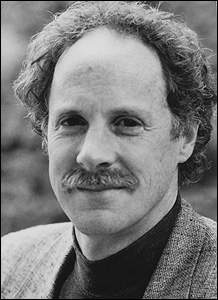![]()
Departments
![]()

|
Week of 18 September 1998 |
Vol. II, No. 6 |
Feature Article
Have you read Blood?
New book puts BU science journalist in circulation
by Eric McHenry
Doug Starr finds it a fascinating irony: the social agenda of the Third Reich, which held blood to be an inviolate symbol of racial purity, contained the germ of its own destruction -- the Nazis literally bled themselves white.
In the 1930s, German hematologists were the world's envy. That changed quickly with the ascendance of Hitler's party.
"First, they kicked out all of the Jews, and there were great doctors among the Jews," says Starr, COM associate professor of journalism and author of a new book about the economic and social history of blood. "Second, they started retreating into German folk medicine and quackery, and they rejected all foreign biology. Third, they permitted only certified Aryans to be blood donors, and there just aren't a lot of certified Aryans in the world."
|
|
|
Doug Starr
|
"In World War II, the Nazis had no plasma products," Starr says. "And the American, British, and French armies basically lived on plasma. If you were in the German army and were shot, you were in big trouble. I have intelligence reports of American reconnaissance units that were finding wounded German soldiers bled white. It got so pathetic that American doctors would sometimes just give the plasma to the German wounded."
Starr's book, Blood: An Epic History of Medicine and Commerce (Knopf), is rich with such anecdote. "Clear-eyed and wrought with superb attention to detail," says Publishers Weekly, "this is first-class science writing." It begins in 17th-century Paris, where a physician to Louis XIV is attempting an early transfusion (of lamb's blood into a madman), and makes its way toward the present day, pausing to show the ways that blood has shaped each epoch. Starr, a science journalist, says the project began in 1992 as an article about the development of artificial hemoglobin, but grew quickly to its current dimensions.
"As I started looking into it," he recalls, "I realized that the story wasn't just artificial hemoglobin, but hemoglobin and blood and blood products. Each time I touched the story, it got bigger. I discovered this fascinating history, a huge part of which took place in Boston. At the first touch the story went back to World War II, and after that it went back several hundred years."
Again and again in his research, Starr says, he was struck by the similarity of blood to another historically significant natural resource: oil. Both are organically based liquid products. Both have tremendous monetary value, which multiplies when they are broken down into their constituents. And both have figured prominently in geopolitical conflicts. The parallel is a thematic vein that runs through the book. For all its similarities to oil, however, Starr believes blood is decidedly more interesting.
"Number one, you don't get oil for free," he says. And while oil represents a much larger international industry, the market looks upon blood as more precious by far: a barrel of oil today fetches about $13; the same quantity of blood is worth some $20,000.
"Number two, if something's wrong with oil, it doesn't spread fatal diseases," he says. "And number three, oil is not absolutely shrouded in mysticism, religion, nationalism. These things cause people to act really spooky when you get on the topic of blood."
Starr conducted hundreds of interviews in writing the book and visited nine different countries. But Boston's prominence in the story of blood was what made the project both feasible and attractive to him. If plasma were oil, he says, the United States would be OPEC: it supplies the world. And the technology that gave rise to the American blood industry grew out of semisecret research undertaken at Harvard Medical School during World War II. Several of the book's chapters involve Dr. Edwin Cohn, a protein chemist who developed the method by which blood is broken down into its protein components, such as albumin and gamma globulin. This contributed greatly to the durability, and portability, of blood at a crucial time.
"It gave quite a strategic advantage to the Allies because the Germans didn't have anything like it," says Starr. "And after the war, it really industrialized blood. It made it usable in the same way that cracking oil made it usable for the petrochemical industry."
|
|
Starr's book opens with an
account of this early transfusion, illustrated in a
1692 German medical textbook. The physician,
Jean-Baptiste Denis, believed the lamb's blood --
rich in gentle "humors" -- would pacify the madman
Antoine Mauroy.
|
The topic led him inevitably to the AIDS epidemic, and many of the people with whom he became familiar in the course of his research died before it was complete. Hemophiliacs, he says, are a group whose losses have been obscured by the sheer magnitude of the AIDS crisis. Their dependency upon a component of plasma called Factor 8, a protein that acts as a blood-clotting agent, caused many thousands to contract HIV in the days before donors were screened for it.
"The problem is that in order to make a vial of Factor 8, you need to concentrate the plasma of thousands of people," Starr explains. "So the average hemophiliac makes contact with millions of blood donors. And there was a period in the early to mid-80s when virtually all of the Factor 8 was contaminated with HIV because of those proportions.
"Hemophilia hits mostly boys," he says. "So you've got all these young men dying of AIDS because of a drug therapy that was designed to save their lives. This was the penultimate tragedy of the entire saga: this mystical liquid that people used to be afraid of became utterly mastered and utterly industrialized, but then not quite. It also carried viruses that killed tens of thousands of people."

